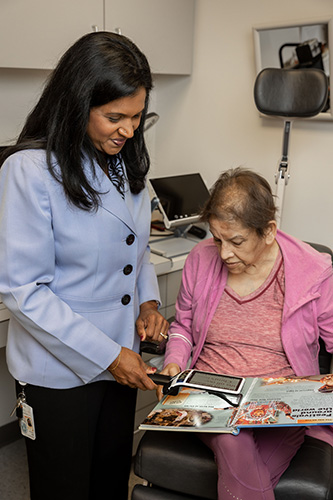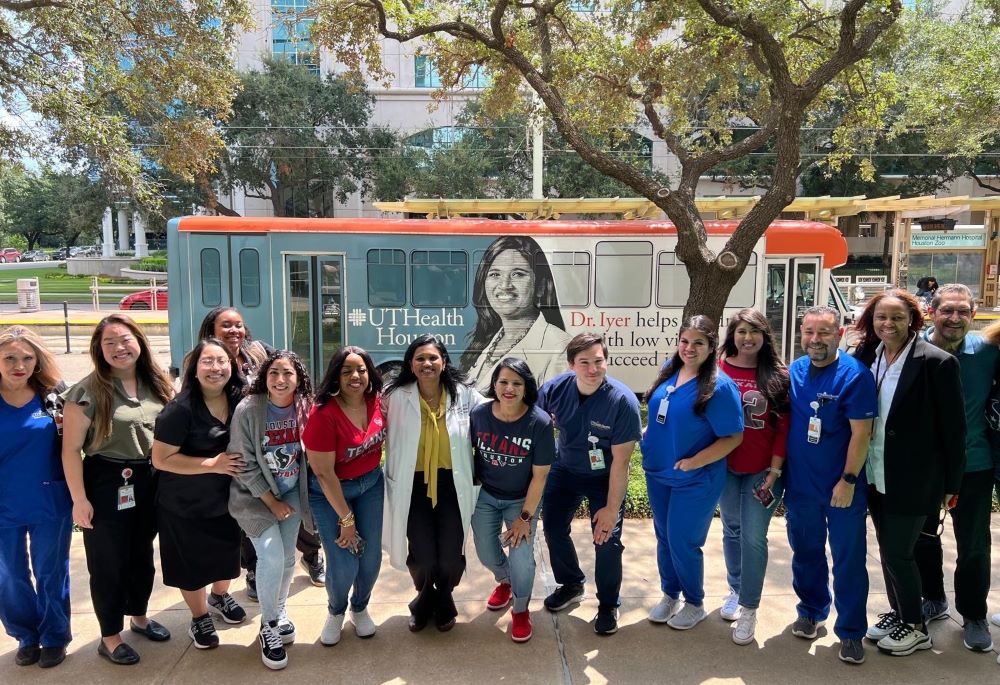
Many conditions, some specific to the eye and some that affect the whole body, can cause a person to lose some of their vision. With vision rehabilitation at the Cizik Eye Clinic, a patient can enhance their visual function, improve their quality of life, and maintain independence. Some of the more common low-vision conditions treated by doctors at the Cizik Eye Clinic include:
Macular Degeneration
Macular degeneration is the leading cause of vision loss in the United States. It is often the result of aging, but can be exacerbated by smoking, diabetes, and prolonged sun exposure. Patients might first notice difficulty reading and subtle distortions, such as straight lines that appear wavy. They may later notice a loss of detail vision that makes it difficult to read, write, drive, cook, watch TV, and recognize faces.
Because peripheral vision is always retained, an individual with macular degeneration never becomes completely blind. The brain selects an area just outside the center to be used as the new focal point, making it possible to train a patient to maximize the use of their residual vision. Magnification of varying levels may be needed for tasks, as well as training and strategies to help patients maintain independence. Your doctor may also talk to you about taking supplements, increasing lighting, and controlling glare with special blue bocking filters.
Glaucoma
High pressure inside the eye is the leading cause of blindness in adults. It can happen so gradually that people aren’t even aware until the condition has advanced. Vision lost because of glaucoma can’t be restored, making it important to have regular eye exams that include measuring eye pressure. If glaucoma is recognized early, vision loss can be slowed or prevented.
Depending on the severity, individuals with glaucoma may experience loss of peripheral vision, inability to drive at night or day, increased glare, loss of depth perception, and overall sensation of being in a fog. Minimal magnification along with training, increased lighting and contrast, and glare control or filters may be recommended by your low vision doctor.
Stroke and Vision Loss
When a person’s blood supply to the brain is interrupted by a stroke, bilateral visual field loss may occur. This is typically called hemianopia, and usually affects half the visual field in each eye, depending on which area of the brain was affected by the stroke. Patients may have trouble reading, driving, running into objects, and navigating crowded places.
While traditional magnification is usually not helpful in these cases, patients may benefit from peripheral field enhancing systems. Training in scanning and compensatory strategies can help improve independence. Training in reading, writing, and daily activity strategies may be recommended. Driving requirements may be discussed and road readiness may be assessed.
Retinitis Pigmentosa
Retinitis Pigmentosa can cause gradual bilateral loss of peripheral vision, ultimately leading to tunnel vision. Early signs include difficulty with night vision, which can cause problems driving. Patients may also notice that they fall, bump, and drop items more.
Occupational therapy and orientation mobility may be recommended by your low vision doctor. Minification or field expanding devices may be beneficial. Your doctor may also recommend increased lighting.
Diplopia
Diplopia, or double vision, can be caused by a variety of problems with the cornea, lens, or brain. An injury, aneurysm, tumor, migraine, or stroke can cause double vision. Double vision that does not require surgery to correct is usually treated with prisms or partial patching and muscle retraining.
Diabetic Eye Issues
Patients with diabetes have specific eye needs to be addressed in the low vision examination. Diabetics need to be able to fill insulin syringes, take medications, test their blood sugar, and read food nutrition labels. Because diabetics tend to have issues with their feet, they may need to see a podiatrist to help monitor changes there.
Diabetics may also experience fluctuations in vision related to their blood sugar levels. As the blood sugar fluctuates, the shape of the human crystalline lens changes. Before prescribing eyeglasses for a diabetic patient, doctors frequently retest the patient on another day to test for these fluctuations.
Diabetic Macular Edema
Macular edema is a swelling of the delicate macular tissue in the center of the retina. It causes a loss of central detail vision and visual acuity. Macular edema can be treated if identified in the early stages. Your optometrist or ophthalmologist can detect this swelling through a dilated retinal exam with a microscope and special lenses. Magnification and increased lighting and contrast can usually help with this condition.
Diabetic Retinopathy
Proliferative Diabetic Retinopathy is the more dangerous condition. It has the potential to cause profound vision loss by damaging the small blood vessels of the retina. Chemicals are released from the retina that can cause abnormal blood vessels to grow. These blood vessels break and bleed creating scar tissue within the eye. As the scar tissue contracts, it may pull on the retina leading to a retinal detachment. Regular visits with your eye doctor are extremely important to ensure timely treatment which can prevent further vision loss. High powered magnifiers and electronic reading machines (CCTVs) may be required to help you read if you are in this stage of the disease. Laser treatment to the periphery can cause difficulty with mobility, particularly in low light and nighttime. You may be prescribed Occupational therapy training and mobility training by your doctor along with a home assessment to ensure your safety and reduce risk for falls.
Reduced Vision After Laser Surgery
Laser treatment is crucial in saving the sight of many diabetics. Laser, however, causes other visual problems that should be addressed by the low vision specialist, including glare problems, loss of contrast sensitivity, and night blindness.
Pan-retinal laser treatments require hundreds of laser burns across the peripheral retina. By lasering these peripheral areas, more oxygen is available to the supply the crucial center of the retina, where our sharpest vision exists. Unfortunately, some side vision may be sacrificed. This can cause difficulty with driving, walking, and depth perception. Some of these issues can be addressed with appropriate lighting and contrast enhancement. Your doctor may also talk to you about driving cessation, based on the level of vision loss.
The doctors and staff at the Cizik Eye Clinic strive to provide each patient with the best care using the newest technology in low vision rehabilitation. New patients should plan on spending two to three hours in the office for their first exam, which will be much more extensive than a typical eye exam and may include:
Medical History
Information is collected about your immediate family’s health and your overall health, including medications, smoking, and sun exposure.
Ocular History
A history is taken regarding your vision, recent changes to your vision, eye diseases, previous eye treatments, surgeries, injuries, and the date of your last eye exam.
Low Vision History
Information is collected about how you use your eyes and function in your daily life. You will be asked about when your vision problems began and whether any activities are becoming difficult, such as reading, watching TV, recognizing faces, driving, and cooking. You will also be asked about any prior vision rehabilitation services you’ve had.
Low Vision Refractive Assessment
Low Vision Refraction is done by the doctor to determine your correction and is more complex than a regular eye exam. This is an important step to ensure that you are wearing the best correction possible. An assessment for high powered bifocals and computer glasses may be necessary as well.
Low Vision Adaptive Assessment
Your doctor will look at the patient’s various functional difficulties and determine the best low vision devices, tools and strategies to help achieve the patient’s goals. This could relate to reading, watching TV, driving, using computers, and more. They assess the needs for help with glare and light sensitivity issues as well. Microscopes, telescopes, magnifiers, bioptic systems, sun wear, computer adaptations and video magnifiers are dem class="h5"onstrated and recommended as needed for the patient.
Ocular Health Assessment
All low vision patients must complete a comprehensive ocular health assessment. This is usually done by your optometrist or ophthalmologist. Patients who have not had a complete eye exam within the past six months will be asked to get a comprehensive eye exam prior to seeing the low vision doctor. Patients receiving active treatment can check out loaner units until treatment is completed.
Supplemental Testing
Depending on a patient’s condition, it may be necessity to perform additional tests to assess different aspects of the patient’s vision. These tests may include a glaucoma test, visual field testing and microperimetry testing, which maps the usable area of your central vision.
Patient Plan and Education
Our doctors are committed to educating patients on their condition and helping them live more productive and independent lives. They work with the patient to reach their goals through low vision rehabilitation and devices. They also discuss new research and treatment options about the condition.


